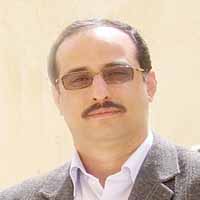A survey of the impact of mirror neuron systems stimulation on development of receptive language, expressive language and speech in 5-8 year, female, Persian, autistic children
Author(s):
Abstract:
Introduction
Recent advances in neuroscience have given rise to the discovery of new neurons called mirror neurons (1, 2 and 3). The current study aims to investigate the association between mirror neuron stimulation through purposeful movement imitation and verbal imitation with language development of autistic children.Method
The current research used a experimental, applied and available sampling design. Accordingly, first, the researchers designed an applied and easy model for autistic children rehabilitation based on mirror neurons stimulation using purposeful movement imitation and verbal imitation. Then, based on (TPR) technique, an 8-year-old autistic girl underwent an pilot study for 12 sessions lasting 4 weeks in Iran University of Medical Sciences, Faculty of Rehabilitation Sciences, whereby positive and effective results were observed; then, other samples, i.e. five monolingual, Farsi-speaking autistic girls aged 5-8, were selected by available sampling and underwent 42 sessions during 14 weeks (three 20/30-minute session in each week), then the development of their receptive-expressive language skills as well as their speech was evaluated using Newsha Developmental Scale. Each sample, as a control sample, was evaluated before and after speech therapy courses based on mirror neurons stimulation. In addition, after a two-month suspension of the 14-week course, all samples were again evaluated with scoring Table; finally, the results stability was evaluated. SPSS (version 16) was used to do statistical data analysis.Results
the obtained results suggest that there is a significant difference between pre-test and post-test scores of receptive language (pConclusion
mirror neuron stimulation through purposeful movement imitation and verbal imitation in autistic children positively affects development of receptive language, expressive language and speech skills. Therefore, this method can be used as a complementary technique in speech therapy of autistic children.Keywords:
Language:
Persian
Published:
Advances in Cognitive Science, Volume:18 Issue: 1, 2016
Page:
47
magiran.com/p1553802
دانلود و مطالعه متن این مقاله با یکی از روشهای زیر امکان پذیر است:
اشتراک شخصی
با عضویت و پرداخت آنلاین حق اشتراک یکساله به مبلغ 1,390,000ريال میتوانید 70 عنوان مطلب دانلود کنید!
اشتراک سازمانی
به کتابخانه دانشگاه یا محل کار خود پیشنهاد کنید تا اشتراک سازمانی این پایگاه را برای دسترسی نامحدود همه کاربران به متن مطالب تهیه نمایند!
توجه!
- حق عضویت دریافتی صرف حمایت از نشریات عضو و نگهداری، تکمیل و توسعه مگیران میشود.
- پرداخت حق اشتراک و دانلود مقالات اجازه بازنشر آن در سایر رسانههای چاپی و دیجیتال را به کاربر نمیدهد.
In order to view content subscription is required
Personal subscription
Subscribe magiran.com for 70 € euros via PayPal and download 70 articles during a year.
Organization subscription
Please contact us to subscribe your university or library for unlimited access!


